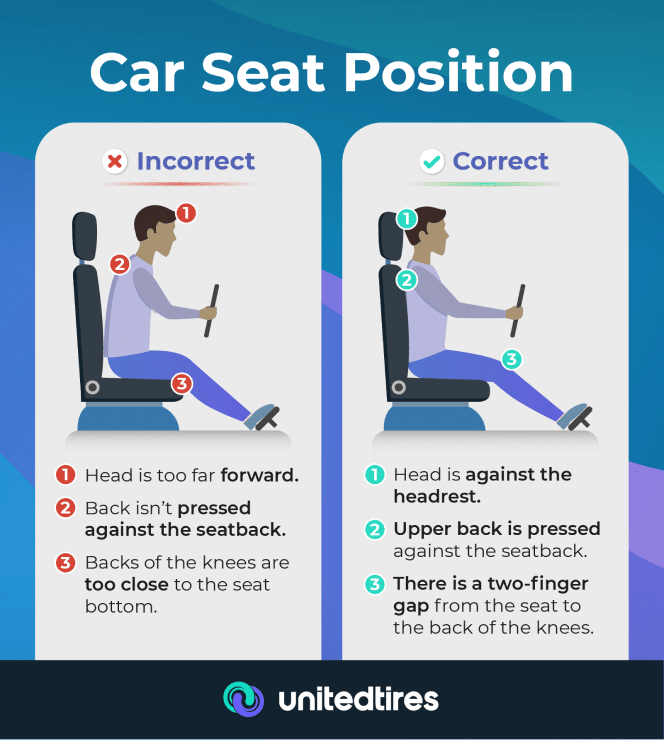Driving Posture Tips, Tricks, and Stretches for a Long Drive

Driving Posture Tips, Tricks, and Stretches for a Long Drive
Road trips can be sources of endless fun. Long trips through an idyllic countryside are quaint and relaxing. Let’s face it, though, sitting in a car for hours can hurt. Between stiff limbs and aching joints, a long drive isn’t always comfortable.
Often, these aches and pains can be mitigated through simple posture adjustments. A slight seat adjustment or some low-impact stretching can make all the difference. Small changes can lead to beneficial results.
If road trips and long drives cause you pain and discomfort, then these driving posture tips and tricks are for you.
Make Sure Your Seat is Adjusted
Most of your proper driving posture begins with the placement of the seat. A properly aligned driver’s seat will provide ergonomic support to minimize pain and fatigue.
Start by adjusting the seat distance. Make sure you can operate the pedals with your legs somewhat bent. Your arms should comfortably reach the steering wheel while slightly extended. There should be no pain or fatigue in your arms or shoulders.
Next, check the angle of the back. Your entire back must be in contact with the seat for proper support. Keep the angle no more than 110 degrees. You should also be able to see all mirrors from this position.
The seat should be flat, and the back of your knees should be a couple of inches from the seat itself. When adjusting the seat for visibility, make sure you can read your instrument panel and the road without moving your head. If you have existing injuries, such as back pain, then use lumbar supports and supporting pillows to ensure a smooth ride.
Finally, adjust your headrest. When doing so, remember the following tips:
- The headrest should be aligned to meet the center of your head.
- The headrest must always be within four inches of your head to prevent whiplash.
- The top of the headrest should be no higher than the top of your head.
These adjustment settings are designed to be both safe and comfortable. Though there is some room for specific preferences, straying too far can lead to undue pain or fatigue. Start with these tips, and adjust slowly to maintain the best ratio of comfort and safety.

Reassess the Steering Wheel Position
Holding your arms outstretched for long periods isn’t often comfortable. With a poorly positioned steering wheel, the driver may feel neck and shoulder pain. However, adjustments are quick and simple.
After the seat position is set, adjust the steering wheel so that your chest is 10 to 12 inches away. Your arms should have a slight bend. With your arms fully extended and your back flush against the seat, your wrists should rest on the steering wheel.
Hand placement is also important. Though many might have learned the “10 and 2” placement, this is now outdated. The best positions are now “9 and 3 o’clock.” This placement reduces the chance of airbag injuries, and it allows the driver to rest their elbow on the armrest.
When holding the wheel, be sure to:
- Grip lightly with your fingers
- Bend your arms at an angle of 120 degrees
- Keep your shoulders relaxed
- Rest your elbows on the armrests, if possible
This steering wheel posture will minimize stress on your neck, arms, and shoulders. These tips also ensure that you are best positioned for safe and responsible steering wheel control.

Remember Your Stretches
Even with the best posture, you’ll need to take breaks now and then. Pulling off at a rest area and taking some time to stretch will improve blood flow and ease your muscles. A break will also keep your mind clear and focused. And when staring at the road for long periods of time, even your mind can start to ache. Stretching can also help reduce the risk of chronic pain and injuries.
Always do the following stretches when the car is stopped and parked. When you’re in a safe place, these areas will benefit from targeting stretching:
- For drivers, focus on stretching your neck, shoulders, and back. This will increase blood flow and reduce strain and soreness.
- Passengers should keep their backs and arms stretched and limber. Don’t forget your glutes to relieve tightness and tension.
- Remember your legs! Stretch your hips, legs, and ankles to keep blood flowing and muscles loose during a long drive.
You can also take a short walk. This will help clear your mind and increase your circulation. An elevated heart rate will help kickstart your entire system and get you ready to slide back behind the wheel.
Taking trips can be a great way to escape and have fun. Without the proper posture, though, the journey can cause plenty of pain and discomfort. Before your next road trip, ensure your seat and steering wheel are adjusted for comfort and safety. Of course, always wear your seat belt. If you start to feel pain or fatigue, pull over into a safe location. Then, stretch your muscles and joints, and clear your head before you continue.


